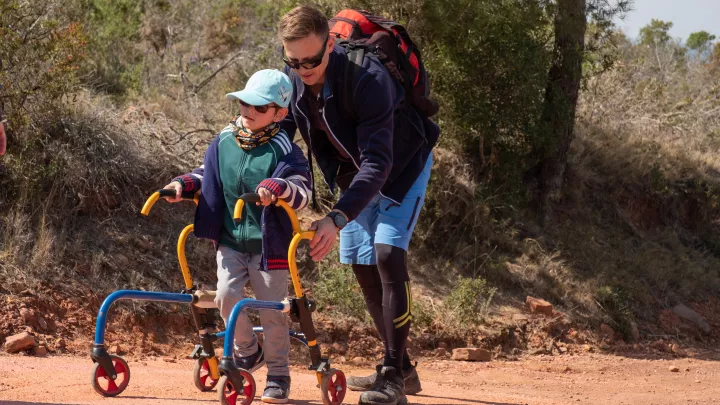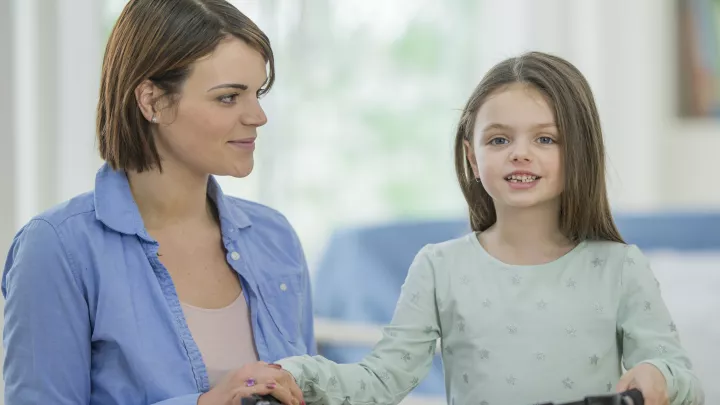Baclofen Pump Clinic for Children
Children’s Health Los Angeles is one of the few programs on the West Coast with expertise in baclofen pump therapy for children. Your child may benefit from this treatment if oral medications fail to relieve muscle stiffness and severe spasticity. We tailor treatment to your child’s unique needs, making it possible to achieve lasting relief.
Pediatric Intrathecal Baclofen Pump Therapy for Spasticity: Why Choose Us
When you come to Children’s Hospital, your child benefits from leading pediatric neurologists who care for children with difficult-to-treat spasticity. Our pediatric Movement Disorders Clinic has a national reputation for care excellence. You can count on us for appropriate therapies tailored to your child’s needs.
Highlights of our program include:
- Team approach: Our multidisciplinary team features trusted specialists who work together to find the best treatment for your child. We consider every available option and may start with standard therapies, such as oral medications. Movement disorder specialists work alongside physical and occupational therapists as well as surgeons, when necessary.
- Comprehensive care: Baclofen pump therapy may be one of many treatments that help your child stay comfortable and pain free. Children’s Hospital offers an extensive range of therapies, including botulinum toxin injections. Learn more about treatments for children with movement disorders.
- Support: Our support services can make life with spasticity a little less stressful for your child and family. Child Life specialists use age-appropriate techniques to explain what to expect and ease your child’s concerns. Licensed clinical social workers connect families in need with helpful resources.
More Information About Baclofen Pump Therapy
Baclofen is a medication commonly used for treatment of spasticity. It helps loosen up abnormally stiff muscles. Treatment usually starts with baclofen taken by mouth or G tube (enteral baclofen). Unfortunately, enteral baclofen is not effective enough in some children, or it can causes disrupting side effects like drowsiness.
Intrathecal baclofen pump therapy uses an implantable pump to deliver baclofen directly into the fluid that surrounds the spinal cord. This area is called the intrathecal space. By delivering the medication directly to the intrathecal space, a much lower baclofen dose is needed, minimizing side effects. The amount of intrathecal baclofen can be fine tuned to each child’s needs and daily schedule for safe and effective control of spasticity and pain.
Benefits of Baclofen Pump Therapy in Children
Intrathecal baclofen pump therapy has many benefits, including:
- Minimizing side effects, such as sleepiness, nausea and dizziness
- Delivering a consistent medication dose for continuous 24-hour symptom relief
- Improvement in muscle control that helps your child get more out of physical, occupational and speech therapy
- Providing long-term control of spasticity and potentially reduced spasticity-related complications
- Flexibility to discontinue treatment, if necessary, by turning the pump off or surgically removing it
- Improvement in quality of life for your child and family
Steps to Getting a Baclofen Pump
Before placement of an intrathecal baclofen pump, movement disorder experts perform an extensive evaluation to find out if intrathecal baclofen treatment is right for your child. Most children have tried at least two medications taken by mouth or G tube before an intrathecal baclofen pump is recommended.
The next step is usually a screening test. This takes about 6 to 8 hours. A guided spinal tap is performed and a single dose of intrathecal baclofen is delivered into the fluid around the lower spinal cord. The spinal tap is performed by our interventional radiologist using imaging assistance to ensure accuracy and minimize discomfort.
After receiving the test dose, your child will be closely monitored for at least 4 hours to determine the response to the medication. It takes about 60 minutes to start seeing effects from the test dose. The full effects are reached after four hours. The effects typically last 8 to 12 hours and by the next day the intrathecal baclofen should be out of the body.
If your child has a positive response during the intrathecal baclofen trial, and you and our movement disorders specialist may decide to proceed with placement of a baclofen pump. Your child will then be referred to our nationally recognized pediatric neurosurgeons.
What to Expect at Our Baclofen Pump Clinic
In the early stages of treatment, your child comes to our clinic every 1 to 2 weeks so our pediatric neurologist can check the pump and make adjustments to the intrathecal baclofen dose. A magnetic programmer is used to change the dose and timing of medication delivery.
As symptoms improve, visits to our clinic will be less frequent. This will depend on your child’s intrathecal baclofen dose. During these visits, we refill the pump with medication and adjust the dose and schedule to fit your child’s needs.
About baclofen pump implant surgery
Your child receives anesthesia to remain asleep during the procedure. Most children go home the day of the procedure. On rare occasions, a short hospital stay is necessary. This approach is necessary if we need to rapidly increase the baclofen dose.
During the pump placement, the neurosurgeon:
- Makes a small incision and places the pump underneath the skin of the abdomen
- Connects one end of the catheter to the pump
- Makes a small incision in your child’s back and places the other end of the catheter into the fluid surrounding the spinal cord
- Closes both incisions


